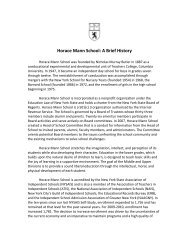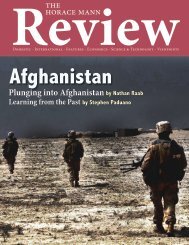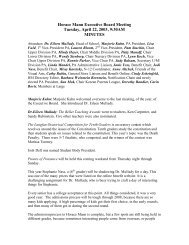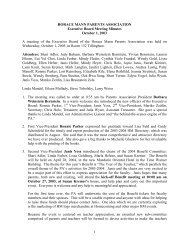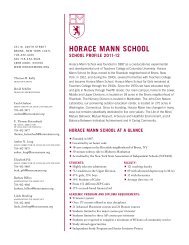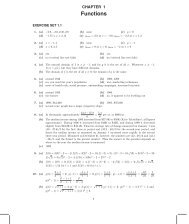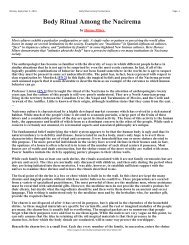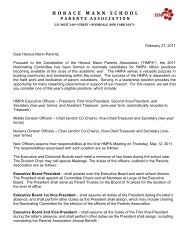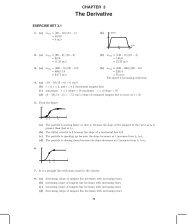horace mann school's publication for gender issues
horace mann school's publication for gender issues
horace mann school's publication for gender issues
Create successful ePaper yourself
Turn your PDF publications into a flip-book with our unique Google optimized e-Paper software.
Opinions arts sports domestic <strong>horace</strong> health international <strong>mann</strong><br />
sports<br />
Equitable<br />
Athletics:<br />
Gender<br />
Identity in<br />
Track<br />
BY COURTNEY HODRICK<br />
Canadian runner Jennifer<br />
McCreath is busy training <strong>for</strong> her<br />
25 th marathon, the Newfoundland<br />
Provincial Marathon on September<br />
26 th. The race will be her first of the<br />
fall, after she raced five in April and<br />
May, including the famous Boston<br />
Marathon. However, training isn’t<br />
all she’s been up to. As a part-op<br />
transitioning transsexual woman,<br />
McCreath is also undertaking the<br />
process of medically adjusting her<br />
sex organs and hormones from<br />
the male body she was born with<br />
to a body that matches her selfidentification<br />
as female. Since<br />
2007, when McCreath realized<br />
her <strong>gender</strong> identity and began<br />
her transition at the same time as<br />
she began running, the increasing<br />
number of openly transsexual<br />
runners has helped begin to<br />
change the face of the sport. In<br />
summer of 2009 and again this<br />
summer, McCreath competed at<br />
Coppenhagen’s World Outgames<br />
not in the male or female<br />
categories, but in a third category<br />
reserved <strong>for</strong> athletes in transition.<br />
This new category enables runners<br />
to compete who were historically<br />
sidelined by the International<br />
Olympic Committee’s rule<br />
mandating that all transsexual<br />
athletes wait to compete until two<br />
years after competing their full<br />
medical transition.<br />
Uni<strong>for</strong>m Inequity:<br />
The Dangers of<br />
Female Sports Attire<br />
BY JASMINE AGHRAVI<br />
Have you ever thought about what your sport requires you to wear Did that<br />
uni<strong>for</strong>m ever affect your decision on joining a particular sport because you felt<br />
uncom<strong>for</strong>table Uni<strong>for</strong>ms are beginning to affect people’s choice in what sport to<br />
play. Take <strong>for</strong> example a young girl who excels at swimming but feels uncom<strong>for</strong>table<br />
with her body in a swimsuit. That girl may opt out of joining the swim team <strong>for</strong> fear<br />
of mockery--a decision that is actually hurting herself in the long run.<br />
“What to wear The sexy tight lycra of some netballers, the skimpy swimsuit<br />
of beach volleyball or the drab polyester of the bowls competitions” Jacqueline<br />
Magnay of the Sydney Morning Herald writes, commenting on how uni<strong>for</strong>ms in<br />
today’s times have discouraged more and more girls, especially teenagers, from<br />
joining certain teams.<br />
In Australia in 2006, the Senate began to question the dress code policies of<br />
sports organizations and study how female depiction in the media is affecting sports<br />
participation. Australian commentators also said there has always been an issue with<br />
women’s athletic uni<strong>for</strong>ms in deciding whether to “make them sexy or appropriate<br />
<strong>for</strong> the sport.” The issue of soft ball players and their shorts being impractical<br />
because of scrapes and bruises they received from sliding was also an issue; the “old<br />
fashioned” longer pants seem too out of style <strong>for</strong> women, yet men still wear them.<br />
In an article titled “‘I’d Feel Ashamed’: Girls’ Bodies and Sports Participation,”<br />
Bethan Evans discusses how the “male gaze” has now been internalized, causing a<br />
constant body pressure and lack of confidence in girls. This means that whether in<br />
a single-sex or co-ed gym class, girls still feel self--conscious participating it certain<br />
sports.<br />
Blogger Janis Inniss, in her May 3 rd blog entry entitled “Sports, Uni<strong>for</strong>ms, and<br />
Gender,” wrote, “The one question that I haven’t been able to get answered in all my<br />
years of watching the sport is this though: Why are the women’s uni<strong>for</strong>ms so much<br />
more revealing than the men’s” She makes the comparison of long knee-length<br />
body suits in male track and field uni<strong>for</strong>ms vs. female’s tight midriff revealing shirts<br />
and underwear-like shorts.<br />
Bloggers and journalists alike seems to wonder about the beach volleyball<br />
uni<strong>for</strong>ms, whose bathing suit-like string bottoms and bra tops seem to attract much<br />
more attention than is given to the actual sport itself.<br />
While no research is currently underway, it is painfully apparent that athletic<br />
apparel <strong>for</strong> girls is affecting teenagers’ decisions to join certain sports. Thus we can<br />
wonder if overall female athletic participation in the country and in the world is<br />
going to decrease if no drastic changes are made to help improve the attire of many<br />
sports.<br />
18



